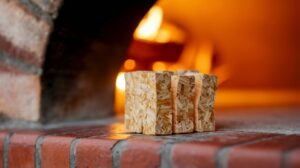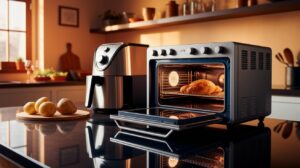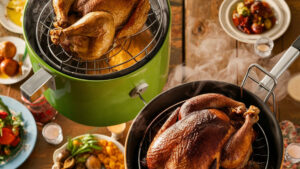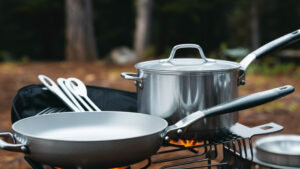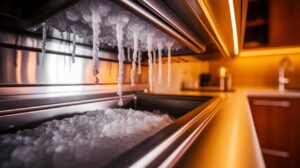To clean and protect your built-in grill from weather damage, follow a few key steps. Regular maintenance ensures your grill remains in good condition for years.
Grilling is a beloved outdoor activity. But exposure to the elements can harm your built-in grill. Rain, snow, and sun can cause rust, wear, and tear. Regular cleaning and proper protection are essential. This helps maintain your grill’s performance and extends its lifespan.
Learn easy, effective methods to keep your grill in top shape. These steps are simple and practical. Your grill will thank you, and so will your taste buds. Let’s dive into the best ways to clean and protect your built-in grill from weather damage.
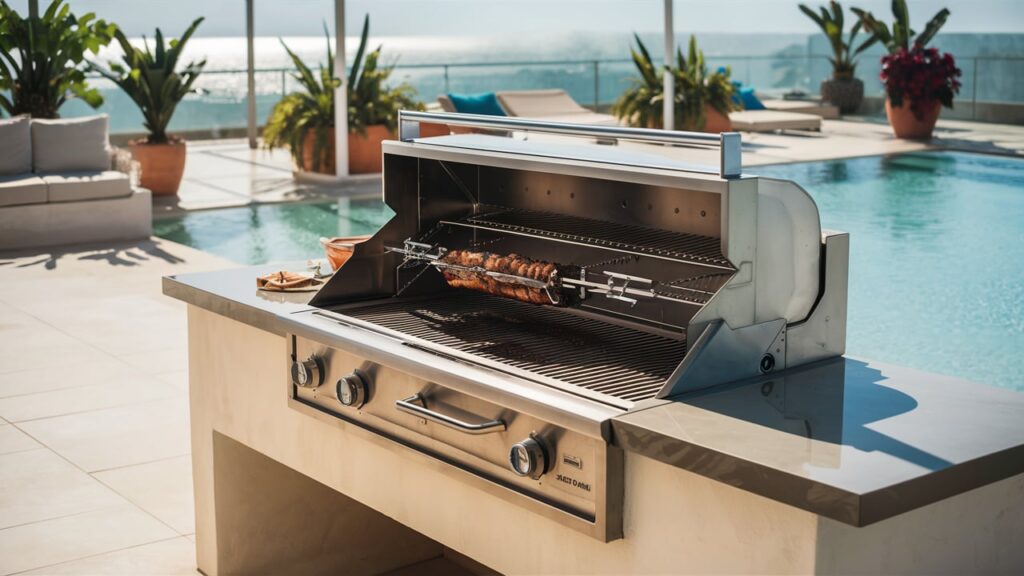
Preparation For Cleaning
Begin with gathering necessary tools such as brushes, soapy water, and protective covers. Remove grates and clean debris to start.
Preparing your built-in grill for a thorough cleaning is crucial in ensuring its longevity and optimal performance. A well-maintained grill not only enhances your cooking experience but also protects your investment from weather damage. By taking a few preparatory steps, you can make the cleaning process more efficient and effective.
Gather Necessary Tools
Before you start, gather all the tools you need. This includes a grill brush, a bucket of soapy water, a sponge, and a soft cloth. You might also need a putty knife for scraping off stubborn residue.
Having everything at hand saves you time and keeps you focused. Imagine having to stop halfway through to search for a missing tool—that’s just frustrating.
Consider adding a pair of rubber gloves to your toolkit. They protect your hands from harsh cleaning chemicals and hot grill grates.
Ensure Safety Measures
Safety should always be your first priority. Make sure the grill is completely cool before you start cleaning. Hot surfaces can cause serious burns.
Disconnect the gas supply if you are using a gas grill. This prevents any accidental ignition.
Wear appropriate clothing that you don’t mind getting dirty. Cleaning a grill can be a messy job, and you don’t want to ruin your favorite shirt.
By taking these preliminary steps, you set yourself up for a smooth and safe cleaning session. What other tools or safety measures do you find essential for grill maintenance?
Basic Cleaning Steps
Keeping your built-in grill clean and protected from weather damage is essential for its longevity and performance. Regular maintenance ensures that your grill stays in top condition, ready to cook up delicious meals whenever you need it. Let’s dive into the basic cleaning steps to keep your grill sparkling and efficient.
Remove Grates And Components
Start by turning off the gas supply and disconnecting the propane tank or gas line. Safety first! Once everything is cool, remove the grates, burner covers, and any other removable components. This makes it easier to clean every nook and cranny.
Place these parts in a bucket of warm, soapy water. Let them soak while you move on to the next steps. This helps to loosen any stubborn grime or grease. You’ll find it much easier to scrub them clean later.
Scrub The Interior
With the grates and components soaking, it’s time to focus on the grill’s interior. Use a grill brush or a sponge to scrub the inside surfaces. Make sure to get into the corners and around the burners.
Have a vacuum handy. It’s great for sucking up any loose debris or ash that might be hanging around. Be thorough. Every bit of dirt you remove now is one less thing to cause problems later.
Once scrubbed, wipe down the interior with a damp cloth. This helps to remove any remaining soap residue. Allow everything to dry thoroughly before reassembling.
How often do you clean your grill? Regular upkeep can prevent a lot of headaches down the line. Share your thoughts and tips in the comments!
Deep Cleaning Techniques
Protect your built-in grill from weather damage with deep cleaning techniques. Remove grease and grime regularly. Use protective covers when not in use.
Regular cleaning can keep your built-in grill in good shape. Yet, deep cleaning ensures it stays free from tough grime and grease. Deep cleaning also extends its lifespan. This section explains how to deep clean your grill effectively.
Clean Burners And Tubes
First, remove the grill grates. They need thorough cleaning. Next, focus on the burners and tubes. Use a stiff wire brush to clean these parts. Pay attention to clogged burner holes. Use a toothpick or paper clip to unblock them. This step ensures even heat distribution. Check the tubes for any obstructions. Clear any debris carefully.
Degrease And Polish
Grease build-up can cause problems. It attracts dirt and pests. Use a degreaser to clean the grill’s interior. Spray the degreaser and let it sit for a few minutes. Wipe away the grease with a soft cloth.
After degreasing, polish the grill’s exterior. Use a stainless steel cleaner. Apply it with a microfiber cloth. This adds a protective layer. It also makes your grill shine. Polishing reduces the risk of rust.
Following these steps keeps your grill in top condition. It also protects it from weather damage.
“`
Cleaning The Exterior
Keeping the exterior of your built-in grill clean is essential. It not only looks good but also extends its life. Regular cleaning prevents rust and weather damage. Let’s dive into how you can clean and protect your grill.
Wipe Down Surfaces
Use a soft cloth and warm, soapy water to clean the surfaces. This removes grease and grime. Wipe in the direction of the grain. This prevents scratches. Dry the surfaces with a clean towel.
Polish Stainless Steel
Stainless steel needs regular polishing. Use a stainless steel cleaner. Apply it with a soft cloth. Rub gently in the grain direction. This keeps the steel shiny and protects it from the elements.
Protecting Against Weather
Your built-in grill is a valuable addition to your outdoor kitchen. Protecting it from weather damage is essential. Rain, snow, and sun can harm your grill over time. Follow these steps to keep your grill safe and looking new.
Use Grill Covers
Seal And Protect Metal
Seasonal Maintenance Tips
Keeping your built-in grill in top shape throughout the year is crucial for its longevity and performance. Seasonal maintenance tips can help you protect your investment from weather damage. Here’s how you can ensure your grill remains in excellent condition season after season.
Winterizing Your Grill
As temperatures drop, taking steps to winterize your grill is essential. Start by giving your grill a thorough cleaning. Remove any food residues and grease, as these can attract pests and cause corrosion.
Next, disconnect the propane tank and store it in a safe, dry place. If your grill has a natural gas line, turn off the supply. Cover your grill with a high-quality, weather-resistant cover to shield it from snow, ice, and moisture.
If possible, move your grill to a sheltered area like a garage or shed. This provides an extra layer of protection against harsh winter elements. By preparing your grill for winter, you can prevent damage and ensure it’s ready for use when warmer weather returns.
Spring Cleaning
Spring is the perfect time to rejuvenate your grill after a long winter. Begin by removing the cover and inspecting your grill for any signs of rust or damage. Check burners, grates, and other components for wear and tear.
Clean the grates thoroughly using a wire brush and soapy water. For stubborn spots, a mixture of baking soda and water can do wonders. Rinse well and let the grates dry completely before reassembling.
Don’t forget to check the gas lines and connections. Ensure there are no leaks by applying a soapy water solution to the connections and looking for bubbles. Finally, fire up your grill to make sure everything is functioning properly. Your grill is now ready for a new season of delicious meals!
Have you ever noticed how a little seasonal maintenance can make a big difference? What’s your favorite spring cleaning tip for your grill? Share your thoughts in the comments!
Storing Your Grill
Properly storing your grill is essential to protect it from weather damage and keep it in top shape for years to come. Whether you live in an area with harsh winters or frequent rain, taking the right steps to store your grill can prevent rust, corrosion, and other weather-related issues. Let’s dive into some practical tips to store your built-in grill effectively.
Choose The Right Location
First, find a suitable location to store your grill. Ideally, place it in a covered area like a garage, shed, or under a sturdy patio cover. This will shield it from direct exposure to rain, snow, and harsh sunlight.
If indoor storage isn’t an option, look for a spot that offers some natural protection, like under an eave or beside a fence. Just make sure the area is well-ventilated to prevent moisture buildup, which can lead to rust.
I once stored my grill on the open deck, thinking a simple cover would suffice. A few months later, I noticed rust spots and had to spend hours scrubbing and repainting. Lesson learned—location matters!
Cover And Secure
Invest in a high-quality grill cover designed to fit your model. A durable cover will keep out moisture, dust, and debris, extending the life of your grill. Look for covers made from weather-resistant materials like heavy-duty vinyl or polyester.
Make sure to secure the cover tightly. Use straps or ties to prevent it from blowing off during strong winds. You don’t want to find your grill exposed after a storm!
Additionally, consider using a grill mat underneath to protect the surface from grease stains and rust. This extra layer can make a significant difference in maintaining both your grill and the area around it.
How do you store your grill? Have you faced any challenges with weather damage? Share your experiences and tips in the comments below!
Regular Inspection
Keeping your built-in grill in top shape requires regular inspection. Regular checks help you identify potential issues early, saving you time and money in the long run. Plus, it ensures your grill is always ready for that spontaneous BBQ.
Check For Rust
Rust can be your grill’s worst enemy. Inspect the grates and body for any signs of rust. If you spot any, clean it off immediately using a wire brush.
Once cleaned, apply a thin layer of cooking oil to the grates. This helps prevent rust from forming again. Pay special attention to areas around screws and bolts.
Inspect Gas Lines
Gas lines are crucial for the safe operation of your grill. Regularly check the lines for cracks or leaks. A simple soap and water solution can help you detect leaks.
Apply the solution to the gas lines and look for bubbles. If you see bubbles, it’s a sign of a leak. Replace any damaged lines immediately.
How often do you inspect your grill? Regular checks can make a big difference. Keep your grill clean and well-maintained for the best BBQ experience!
Frequently Asked Questions
How To Protect A Grill From Weather?
Use a grill cover to shield your grill from rain, snow, and debris. Store it indoors during harsh weather. Clean and dry it regularly to prevent rust. Use a grill mat to protect the ground. Proper maintenance ensures longevity.
How To Clean An Outdoor Built-in Grill?
Clean an outdoor built-in grill by disconnecting the gas, brushing grates, scrubbing with soapy water, and rinsing. Dry thoroughly before use.
Do Built In Grills Need To Be Covered?
Yes, built-in grills need to be covered. Covering protects them from weather damage, debris, and extends their lifespan.
How Do I Keep The Outside Of My Grill From Rusting?
Keep your grill rust-free by cleaning it regularly and applying a protective cover. Use a rust-resistant spray for extra protection. Store it in a dry place.
Conclusion
Maintaining your built-in grill is essential. Regular cleaning prevents damage. Proper covers protect from weather. Use a grill brush for easy cleaning. Store the grill in a dry place. Check for rust and remove it quickly. These steps will extend your grill’s life.
Enjoy safe and tasty grilling for years. Happy grilling!
